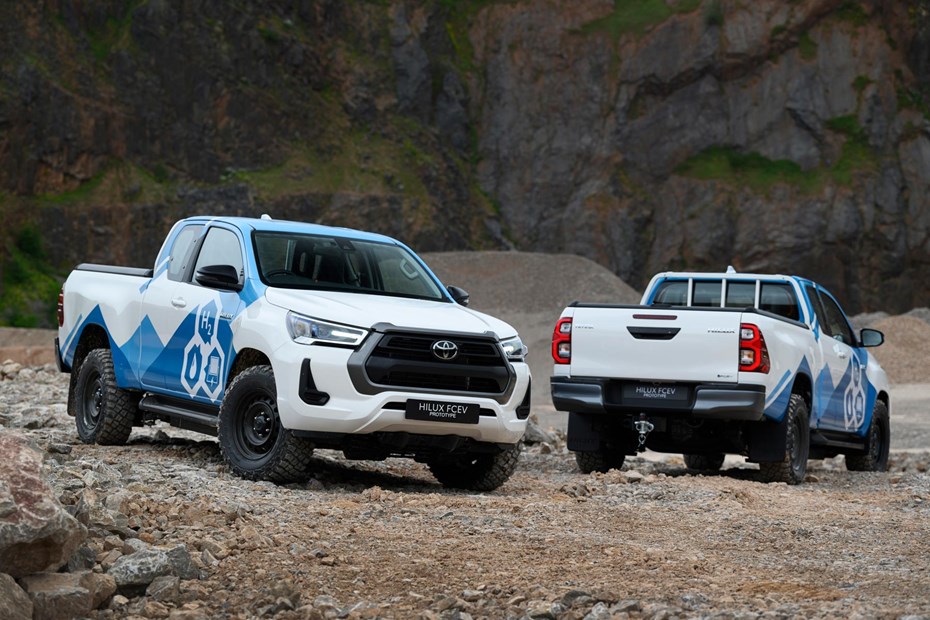The plight of hydrogen-powered vehicles hasn’t been an easy one in the UK in recent years, but there could be a saviour from the world of pickup trucks.
Champions of the tech have had to watch as electric vehicles have soared up the sales charts while hydrogen fuelling stations have closed and models have been withdrawn from sale.
Regardless, in September 2023, Toyota showed off a Hilux pickup truck that was fitted with the powertrain that came out of the no-longer-offered Mirai saloon. This was no one-off ‘look what we can do’ endeavour, with testing continuing and plans tentatively in place for a launch in the coming few years.
Toyota has made 10 prototypes and it has been rigorously testing five of those while the other five were created to let customers and media get a taster of what a fuel-cell Hilux can do. That’s how I ended up at a quarry in the Midlands, learning all about the programme.
What is different about the hydrogen fuel cell Toyota Hilux?
To start off with, let’s take a look at what is familiar about the hydrogen fuel cell Hilux, rather than what makes it different. This project only kicked off in 2022, so, after only two years, it’s perhaps not a huge surprise that Toyota has been marrying existing technology rather than dreaming up radical new concepts.
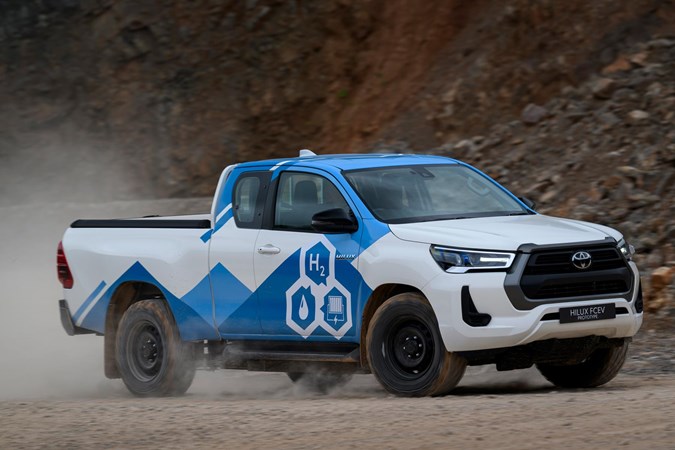
Essentially, this is an extended cab Toyota Hilux (the one with a small second row of seats that you’d be happy in for a short drive, but not several hours and hundreds of miles on the motorway) with the Toyota Mirai’s engine, fuel cell and battery shoehorned in.
The engine goes where the Hilux’s diesel unit usually sits, the three high-pressure hydrogen tanks that can each take 2.6kg of fuel sit underneath the cabin surrounded by a reinforced chassis and the battery is located behind the cabin.
Ah, yes, the battery. This is the surest sign that this is a prototype and one of the major things on the ‘To Do’ list for Toyota. Currently this takes up a big chunk of the loading bay, where it is wrapped in a relatively thin metal container. The expectation is that this wouldn’t be where it sits ultimately, with the hope being that it would end up beneath the rear seats.
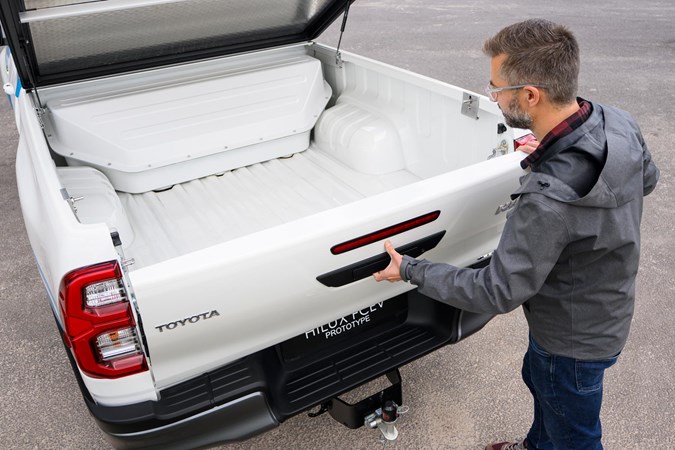
The powertrain itself is fundamentally unchanged from the one in the Mirai, right down to it offering the same 182hp of power and 300Nm of torque from its motor.
The vehicle itself is rear-wheel drive only, which is something else that marks this out as notably different to the diesel version – the idea of a two-wheel-drive Hilux is one that would send the market into shudders.
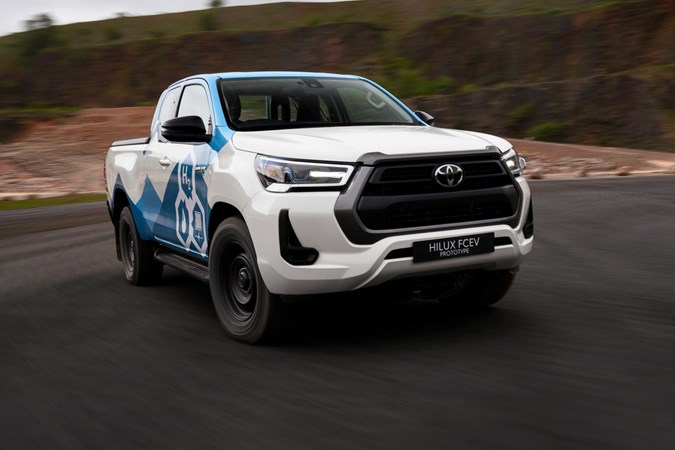
It’s also got not traction control or stability control, but that’s because the engineers haven’t linked the different systems up to talk to one another just yet.
What is the Toyota Hilux hydrogen fuel cell like to drive?
Before I’m allowed out in the FCEV prototype, it’s time for a quick lap of our quarry location in a 2.8-litre diesel Hilux. I’ve driven plenty of these in the past, so it’s a brief refresher more than anything – good truck, tough, powerful engine, workhorse-style cabin. The usual.
Then it’s time to hop into the FCEV, where the immediate impression is one of deja-vu. Because this is a prototype, the base vehicle is barely any different to the diesel, with a couple of minor exceptions. Firstly, the gear selector is the tiny little lever from the Mirai, which therefore looks very out of place in the Hilux’s hefty cabin.
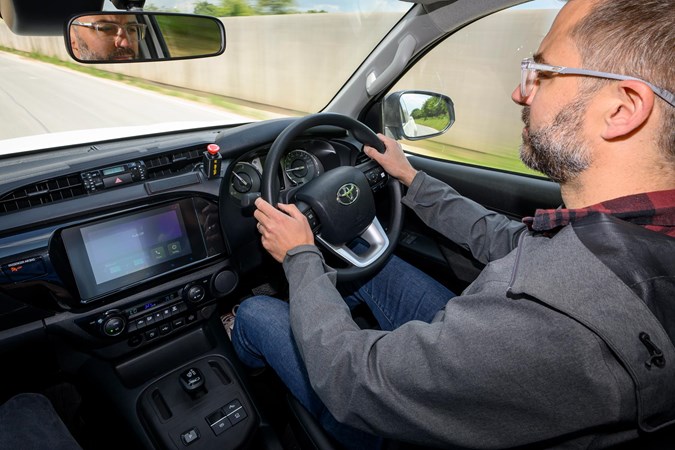
On the information display, the rev counter has been replaced by a battery-charge-level indicator, but all other details including the speedo, steering wheel, even the infotainment screen are all the same. Oh, and there is a big red button attached to a stalk on the dash labelled ‘E Stop.’ Hopefully we won’t have to go anywhere near that one…
To get going it is the familiar button prod, move into D and off you go, at which point I’m struck by the first big change. I’ve driven plenty of electric cars and, more recently, vans, but this is one of the first times I’ve been in a moving pickup truck with such a silent soundtrack. It feels odd, although I’m aware it is lack of familiarity that makes that the case more than anything.
This doesn’t last long as, fortunately or unfortunately, the majority of the test route is on gravel tracks, so the resultant under-wheel noise drowns out the powertrain almost immediately. It also means you are hugely more aware of every stone pinging off the underside of the truck – something brought into focus by the limited number of these vehicles…
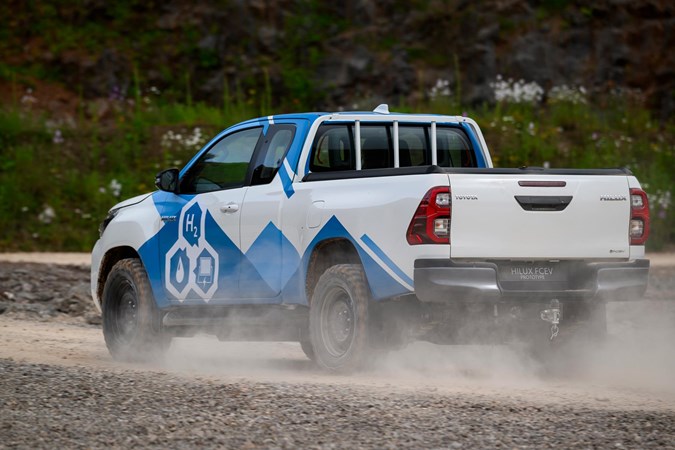
I’m also hyper aware of this when I’m reminded that these rear-wheel-drive vehicles don’t have stability control yet, so the chance of sliding sideways is somewhat higher than in your average pickup. I kept speed within check and the wheels pointing forwards just in case.
As for the powertrain, there are some fundamental differences in how it feels compared to a big lump of a diesel engine. For a start, the 300Nm of torque offered by the FCEV is somewhat lower than the 500Nm in the automatic diesel Hilux. The fuel cell truck performs much more like an electric vehicle, though, with the majority of its oomph delivered from low speeds and with little effort, so it doesn’t feel like it is lacking. This is largely down to the 30mph(ish) speed limit at the quarry – the diesel would likely feel much more capable when attempting on-the-move overtaking manoeuvres, particularly with a load on board.
The figures are undeniably low, though, which might be a stumbling block for buyers that might be erring on the side of caution. A production version might do well to boost these numbers if it can.
How much does the Toyota Hilux hydrogen fuel cell weigh?
Toyota has been very selective with the statistics it has revealed about the Hilux hydrogen, so all we have are the external measurements – nothing on weight or payload just yet. Whether it doesn’t know or just isn’t willing to say it is hard to be sure, but one suspects that if it had a payload of 1,200kg it would be shouting about it.
As a result, it’s impossible to judge whether it would represent good value, be eligible for the beneficial van tax system or be strong enough to take on diesel trucks.
How much will the Toyota Hilux hydrogen cost and when will it go on sale?
Now we’re into real pie-in-the-sky territory, as the hydrogen Hilux hasn’t been officially confirmed for production yet, so we daren’t even estimate a price right now. It probably will go on sale, but probably won’t arrive for at least another couple of years. The powertrain in these prototypes is the second generation and it’s likely that we won’t see a production model until the third generation arrives.
We’re probably also looking at the next generation of Hilux too, to be honest. That’s around three to four years’ time, so 2028 at the earliest.
That might not seem too far off in the grand scheme of things, but the whole project has been remarkably quick up to this point so there is every chance that that pace will continue and we’ll see fuel-cell Hiluxes on our roads soon. Just as long as the infrastructure keeps pace with Toyota…
Just so you know, we may receive a commission or other compensation from the links on this website - read why you should trust us.


